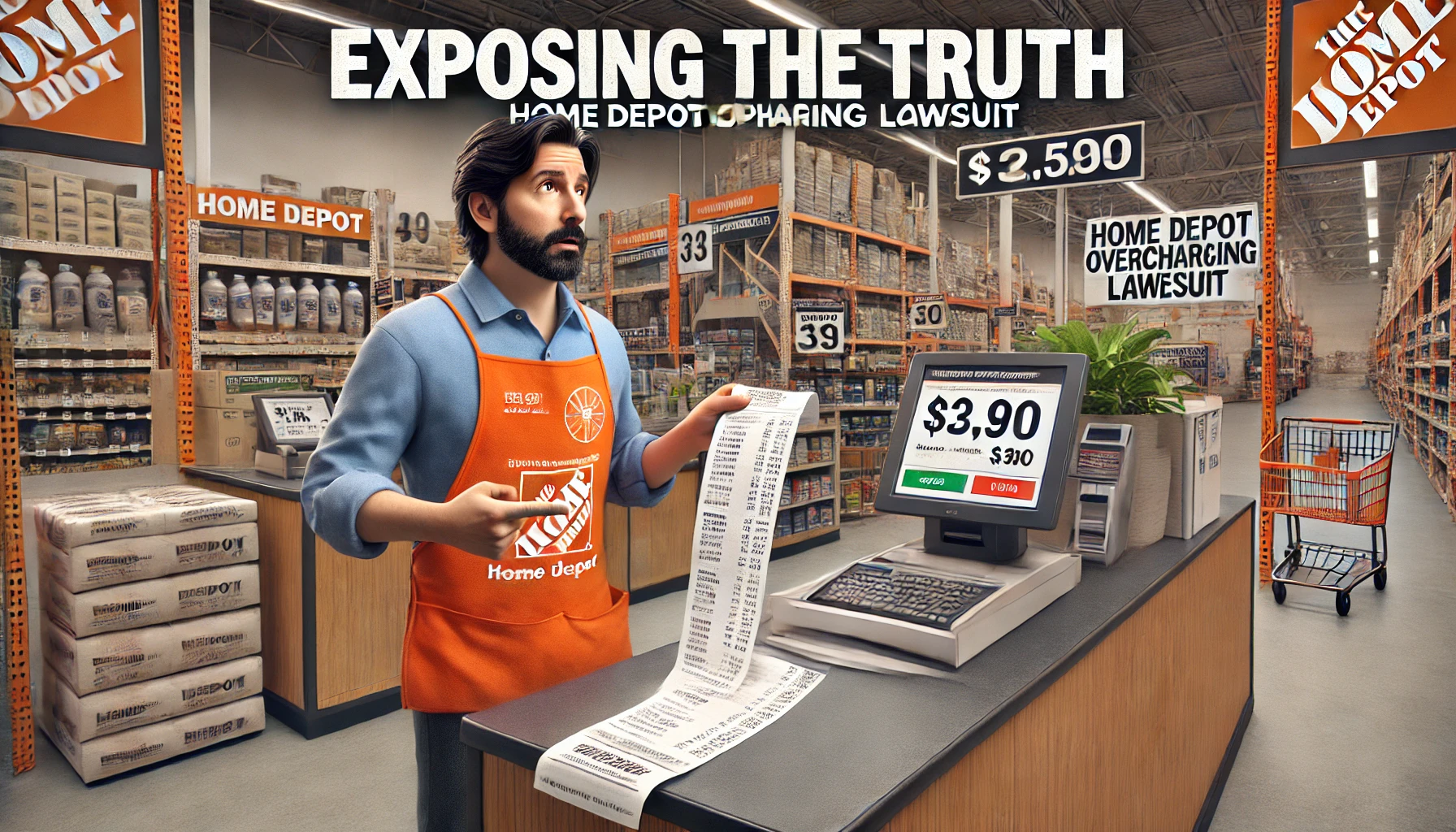Introduction
The Home Depot overcharging lawsuit has become a hot topic, stirring concerns about trust and fairness in the retail industry. At its core, this case shines a spotlight on allegations that Home Depot charged customers more than the prices advertised for certain products and services. For you, this could mean wondering if you’ve ever unknowingly paid more than you should have at one of their stores.
Why does this matter? It’s about more than just a few dollars. It’s about ensuring companies are held accountable for their actions and that you, as a consumer, are treated with respect and fairness. This case has sparked a broader discussion about transparency in pricing and the protections available to you when you shop.
In this article, we’ll explore the origins of the lawsuit, unpack the allegations, and consider what it might mean for the retail giant and for you. We’ll also look at how such cases can shape consumer rights and corporate practices. By the end, you’ll have a clear understanding of the situation and practical steps to protect yourself from overcharges in the future.
What Led to the Lawsuit?
The Home Depot overcharging lawsuit began as customers started reporting troubling inconsistencies in their shopping experiences. Imagine expecting a deal or a fair price, only to discover later that you paid more than what was advertised. That’s exactly what sparked these accusations.
At the heart of the case are claims of price discrepancies, where the price at the checkout didn’t match what was displayed on the shelf. These kinds of errors, whether intentional or not, left many feeling deceived. For example, a sale price might show on the tag, but the regular price appears on your receipt, leading to frustration.
Another significant concern is the presence of hidden fees. These are charges that might not be clearly disclosed or explained, catching customers off guard. Some have alleged that such fees were quietly added during transactions, eroding trust in the company’s practices.
Bulk purchases and special discounts were also common points of contention. Customers who thought they were saving on bulk items or using promotional discounts sometimes found that these savings weren’t applied correctly. This left many questioning whether Home Depot’s systems were failing or if there was a deeper issue with how the company handled pricing.
This lawsuit isn’t just about numbers on a receipt; it’s about fairness. Overcharging, whether it happens due to errors or oversight, chips away at the trust you place in a brand. For many, it feels like a betrayal of the basic expectation that the price you see is the price you’ll pay.
Legal Basis for the Lawsuit
The Home Depot overcharging lawsuit rests firmly on the foundation of consumer protection laws that are designed to safeguard your rights as a shopper. These laws ensure that companies provide accurate pricing and fair billing practices, and any deviation from these standards can lead to serious legal consequences. Let’s break down the key issues fueling this lawsuit.
Violations of Pricing Accuracy Laws
At its core, the case points to alleged breaches of pricing accuracy regulations. These laws require that the price displayed—whether on a shelf, an advertisement, or online—matches the price charged at checkout. If this doesn’t happen, it’s not just an oversight; it’s a violation of your rights as a consumer. Many accusations in this lawsuit claim that such discrepancies were too frequent to be mere mistakes.
Breaches of Trust Under Consumer Protection Acts
Trust is a critical part of the shopping experience. Federal and state consumer protection acts, like the Federal Trade Commission Act, prohibit deceptive practices. In this case, the lawsuit argues that Home Depot’s actions—whether intentional or due to negligence—violated these laws by misrepresenting prices and failing to provide transparency in transactions.
Negligence in Updating Pricing Systems
Another significant aspect of the case is the alleged failure to maintain and update pricing systems. For a company as large as Home Depot, ensuring that pricing systems are accurate and staff are trained properly should be a priority. The lawsuit claims that the company didn’t do enough to prevent errors, which led to consistent overcharging. This negligence, intentional or not, can have legal implications, as companies are required to take reasonable measures to ensure fairness.
Key Allegations Against Home Depot
The Home Depot overcharging lawsuit revolves around several key accusations that have raised serious questions about the company’s pricing practices. These allegations highlight a pattern of issues that left many customers feeling misled and frustrated. Here’s a closer look at what has been brought to light:
Discrepancies Between Advertised and Actual Prices
One of the most common complaints is the mismatch between advertised prices and what customers were charged at checkout. Picture this: you see a product on sale, grab it with confidence, but at checkout, the price on the receipt is higher. This isn’t just disappointing—it feels unfair. Many customers have reported such instances, arguing that it points to systemic issues in Home Depot’s pricing systems rather than isolated mistakes.
Failure to Honor Discounts or Coupons
Another major allegation is Home Depot’s failure to apply promotional offers correctly. Whether it’s a discount advertised on their website or a coupon brought in by a customer, these should be honored without hassle. However, customers have claimed that discounts were either not applied or incorrectly calculated, making them question the reliability of the company’s promotional practices.
Hidden Fees
Hidden fees are perhaps the most frustrating of the allegations. Imagine buying an item only to later discover unexplained charges on your receipt. These fees, which some customers argue were not clearly disclosed upfront, have been described as deceptive. Whether it’s a “processing fee” or another vague charge, these fees can erode trust and leave customers feeling like they were taken advantage of.
How Are Customers Affected?
The Home Depot overcharging lawsuit highlights the real impact on customers, far beyond just monetary concerns. For many, it’s not just about a few extra dollars spent—it’s about fairness, trust, and the frustration of feeling misled. Let’s take a closer look at how this situation has affected people like you.
Paying More Than Expected for Products or Services
Imagine carefully planning your purchases, sticking to your budget, and then finding out later that you were charged more than what was advertised. Whether it’s a small overcharge or a significant difference, it adds up quickly, leaving you feeling cheated. For families and individuals working with tight budgets, even minor discrepancies can disrupt financial plans.
Losing Trust in Pricing Transparency
Trust is at the core of any shopping experience. You walk into a store expecting that the prices on the shelves are the prices you’ll pay. This lawsuit has shaken that trust for many customers, making them question the transparency and fairness of Home Depot’s practices. Once trust is broken, it’s hard to regain, and it can make future shopping experiences feel uncertain or stressful.
The Inconvenience of Disputing Charges
Dealing with overcharges doesn’t end at the checkout counter. For those who notice discrepancies, disputing the charges can become a time-consuming and frustrating process. From calling customer service to gathering proof and waiting for resolutions, this adds an unnecessary burden to your day. It’s not just about the money—it’s about the inconvenience and the effort required to fight for what’s rightfully yours.
Home Depot’s Response to the Allegations
In light of the overcharging allegations, Home Depot has taken several steps to address customer concerns and uphold its reputation. The company has publicly stated that any pricing discrepancies were unintentional and isolated incidents. They have committed to investigating legitimate complaints thoroughly and have implemented measures to prevent future occurrences. This includes enhancing their pricing systems and providing additional training to staff to ensure accuracy at checkout. Home Depot’s legal team has emphasized the company’s dedication to ethical practices and transparency, aiming to rebuild and maintain customer trust.
Potential Outcomes of the Lawsuit
The Home Depot overcharging lawsuit could have significant repercussions for both the company and its customers. Depending on how the case unfolds, there are several potential outcomes that could bring about changes in corporate practices, customer compensation, or both.
Settlement Agreements
One likely scenario is a settlement, where Home Depot agrees to resolve the matter out of court. This could involve compensating customers who were overcharged, either through refunds, store credits, or other forms of restitution. Additionally, Home Depot might commit to revising its pricing systems and internal policies to prevent future discrepancies. Settlements often offer a quicker resolution, sparing both parties the time and expense of a prolonged trial.
Court Rulings
If the case proceeds to trial, a court ruling will ultimately determine whether Home Depot violated any laws. A judgment could clear the company of wrongdoing, but if found liable, Home Depot might face financial penalties, mandatory customer compensation, or reputational damage. A court decision could set a precedent, influencing how other companies handle pricing and billing practices in the future.
Policy Reforms
Even without a formal ruling, legal scrutiny often pushes companies to implement significant changes. Home Depot might introduce stricter pricing policies, enhanced training for staff, or more robust systems for monitoring and updating prices. Such reforms would not only address the allegations but also rebuild customer trust and improve transparency moving forward.
10 Must-Know Insights About Mary Anderson’s Dublin Estate Probate That Could Save You Time and Money
Steps Consumers Can Take
If you suspect you’ve been overcharged during a shopping trip to Home Depot, there are actionable steps you can take to address the issue and ensure you’re treated fairly. By following these steps, you can resolve discrepancies efficiently and even contribute to broader consumer protections.
1. Review Receipts
The first thing you should do is carefully review your receipt after making a purchase. Compare the prices listed on the receipt to the prices displayed on the shelves or in advertisements. Pay close attention to discounts or promotional offers to ensure they were applied correctly. This simple habit can help you spot errors before leaving the store.
2. Contact Customer Service
If you find an overcharge, reach out to Home Depot’s customer service. You can do this in-store by speaking to a manager, or you can contact their customer support team online or by phone. Be prepared to provide evidence, such as your receipt and a photo of the shelf price. Most overcharging issues can be resolved at this step with a refund or store credit.
3. Report to Authorities
If your issue isn’t resolved or you believe the overcharge was part of a broader pattern, consider reporting the matter to a consumer protection agency. Agencies like the Federal Trade Commission (FTC) or your state’s attorney general’s office can investigate pricing discrepancies and hold companies accountable. Reporting such issues contributes to greater oversight and fairness in the marketplace.
4. Join Class-Action Lawsuits
If you discover that the overcharging you experienced is part of a larger lawsuit, you might qualify to join a class-action case. Class-action lawsuits pool claims from multiple customers, increasing the likelihood of meaningful compensation and systemic change. To find out if you’re eligible, consult the lawsuit’s details online or through legal channels.
The Broader Implications for Retailers
The Home Depot overcharging lawsuit serves as a wake-up call for retailers, shedding light on the critical need for transparency and accuracy in pricing. Beyond Home Depot, this case underscores the broader challenges retailers face in maintaining consumer trust and avoiding legal scrutiny. Let’s explore the lessons that the retail industry can take from this situation.
Maintaining Pricing Accuracy
Accurate pricing is the foundation of trust in retail. When customers see a price on a shelf, they expect to pay that exact amount at checkout. Retailers must ensure their systems reflect real-time pricing updates, especially during sales or promotions. Errors in this area can not only lead to customer dissatisfaction but also legal repercussions, as seen in this case.
Regularly Auditing Pricing Systems
Retailers can minimize pricing errors by conducting regular audits of their pricing systems. This involves cross-checking shelf tags, digital pricing systems, and promotional offers to ensure they match across the board. Routine audits not only reduce the risk of overcharging but also demonstrate a commitment to fairness.
Providing Thorough Staff Training
Employees play a crucial role in ensuring that pricing discrepancies are identified and resolved. Retailers should invest in comprehensive training programs that educate staff on how to handle promotions, discounts, and fee disclosures. Well-trained employees can act as the first line of defense in preventing overcharges and addressing customer concerns on the spot.
Being Transparent About Fees and Pricing Policies
Hidden fees or unclear pricing policies are among the most significant factors that damage trust. Retailers must prioritize transparency by clearly communicating all fees and policies to customers upfront. Whether it’s a restocking fee, delivery charge, or bulk discount terms, providing this information avoids misunderstandings and ensures a smoother customer experience.
Final Thoughts
The Home Depot overcharging lawsuit is more than just a legal battle—it’s a wake-up call that resonates with both businesses and consumers. For companies, it highlights the critical need for transparency, accountability, and strict adherence to consumer protection laws. Trust is the foundation of any successful business, and this case demonstrates how quickly that trust can erode when customers feel misled.
For you as a customer, the lawsuit serves as a reminder to stay vigilant. Taking simple steps like reviewing your receipts and being aware of advertised prices can save you from overpaying. If discrepancies arise, don’t hesitate to speak up, whether it’s by contacting customer service, filing a complaint, or joining collective legal actions. Your voice not only protects your rights but also contributes to broader change.
As this case unfolds, its implications for the retail industry could be significant. It may lead to stricter regulations, improved pricing practices, and heightened awareness among shoppers. Whether it results in settlements, policy reforms, or deeper scrutiny of corporate practices, one thing is clear: accountability in retail is non-negotiable.
Ultimately, this lawsuit is a reminder that fairness in pricing is a shared responsibility. Businesses must uphold their end of the bargain with transparent practices, and consumers must remain proactive in protecting their rights. Together, these efforts ensure a more equitable and trustworthy shopping experience for everyone.
Dive into the world of Legal Service with The Expert Law. Visit our website and unlock endless inspiration!





